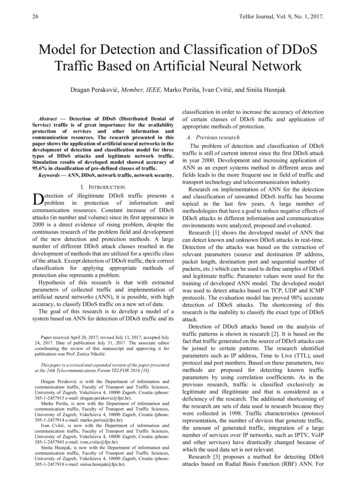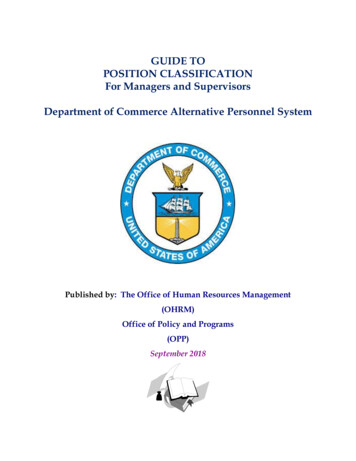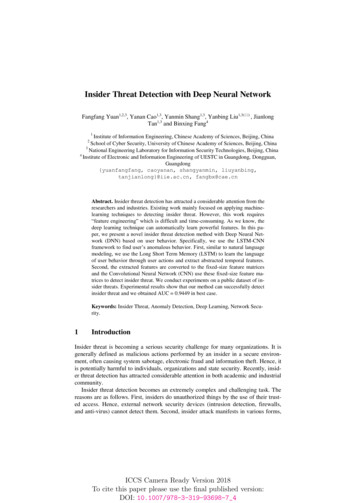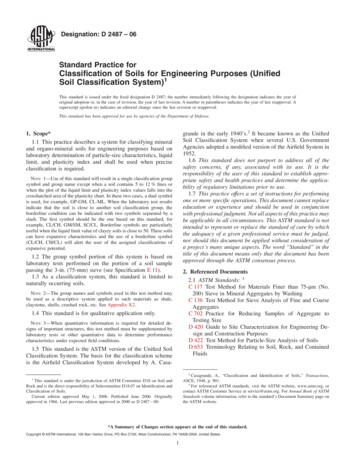
Transcription
26Telfor Journal, Vol. 9, No. 1, 2017.Model for Detection and Classification of DDoSTraffic Based on Artificial Neural NetworkDragan Peraković, Member, IEEE, Marko Periša, Ivan Cvitić, and Siniša HusnjakAbstract — Detection of DDoS (Distributed Denial ofService) traffic is of great importance for the availabilityprotection of services and other information andcommunication resources. The research presented in thispaper shows the application of artificial neural networks in thedevelopment of detection and classification model for threetypes of DDoS attacks and legitimate network traffic.Simulation results of developed model showed accuracy of95.6% in classification of pre-defined classes of traffic.Keywords — ANN, DDoS, network traffic, network security.I. INTRODUCTIONetection of illegitimate DDoS traffic presents aproblem in protection of information andcommunication resources. Constant increase of DDoSattacks (in number and volume) since its first appearance in2000 is a direct evidence of rising problem, despite thecontinuous research of the problem field and developmentof the new detection and protection methods. A largenumber of different DDoS attack classes resulted in thedevelopment of methods that are utilized for a specific classof the attack. Except detection of DDoS traffic, their correctclassification for applying appropriate methods ofprotection also represents a problem.Hypothesis of this research is that with extractedparameters of collected traffic and implementation ofartificial neural networks (ANN), it is possible, with highaccuracy, to classify DDoS traffic on a new set of data.The goal of this research is to develop a model of asystem based on ANN for detection of DDoS traffic and itsDPaper received April 26, 2017; revised July 13, 2017; accepted July24, 2017. Date of publication July 31, 2017. The associate editorcoordinating the review of this manuscript and approving it forpublication was Prof. Zorica Nikolić.This paper is a revised and expanded version of the paper presentedat the 24th Telecommunications Forum TELFOR 2016 [18].Dragan Peraković is with the Department of information andcommunication traffic, Faculty of Transport and Traffic Sciences,University of Zagreb, Vukelićeva 4, 10000 Zagreb, Croatia (phone:385-1-2457915 e-mail: dragan.perakovic@fpz.hr).Marko Periša, is now with the Department of information andcommunication traffic, Faculty of Transport and Traffic Sciences,University of Zagreb, Vukelićeva 4, 10000 Zagreb, Croatia (phone:385-1-2457914 e-mail: marko.perisa@fpz.hr).Ivan Cvitić, is now with the Department of information andcommunication traffic, Faculty of Transport and Traffic Sciences,University of Zagreb, Vukelićeva 4, 10000 Zagreb, Croatia (phone:385-1-2457943 e-mail: ivan.cvitic@fpz.hr).Siniša Husnjak, is now with the Department of information andcommunication traffic, Faculty of Transport and Traffic Sciences,University of Zagreb, Vukelićeva 4, 10000 Zagreb, Croatia (phone:385-1-2457918 e-mail: sinisa.husnjak@fpz.hr).classification in order to increase the accuracy of detectionof certain classes of DDoS traffic and application ofappropriate methods of protection.A. Previous researchThe problem of detection and classification of DDoStraffic is still of current interest since the first DDoS attackin year 2000. Development and increasing application ofANN as an expert systems method in different areas andfields leads to the more frequent use in field of traffic andtransport technology and telecommunication industry.Research on implementation of ANN for the detectionand classification of unwanted DDoS traffic has becometopical in the last few years. A large number ofmethodologies that have a goal to reduce negative effects ofDDoS attacks in different information and communicationenvironments were analyzed, proposed and evaluated.Research [1] shows the developed model of ANN thatcan detect known and unknown DDoS attacks in real-time.Detection of the attacks was based on the extraction ofrelevant parameters (source and destination IP address,packet length, destination port and sequential number ofpackets, etc.) which can be used to define samples of DDoSand legitimate traffic. Parameter values were used for thetraining of developed ANN model. The developed modelwas used to detect attacks based on TCP, UDP and ICMPprotocols. The evaluation model has proved 98% accuratedetection of DDoS attacks. The shortcoming of thisresearch is the inability to classify the exact type of DDoSattack.Detection of DDoS attacks based on the analysis oftraffic patterns is shown in research [2]. It is based on thefact that traffic generated on the source of DDoS attacks canbe joined to certain patterns. The research identifiedparameters such as IP address, Time to Live (TTL), usedprotocol and port numbers. Based on these parameters, twomethods are proposed for detecting known trafficparameters by using correlation coefficients. As in theprevious research, traffic is classified exclusively aslegitimate and illegitimate and that is considered as adeficiency of the research. The additional shortcoming ofthe research are sets of data used in research because theywere collected in 1998. Traffic characteristics (protocolrepresentation, the number of devices that generate traffic,the amount of generated traffic, integration of a largenumber of services over IP networks, such as IPTV, VoIPand other services) have drastically changed because ofwhich the used data set is not relevant.Research [3] proposes a method for detecting DDoSattacks based on Radial Basis Function (RBF) ANN. For
Peraković et al.: Model for Detection and Classification of DDoS Traffic Based on ANNthe development of detection method we have usedparameters such as average packet size, packet sequencenumber, time variance of packet arrival, size variance ofpacket, etc. Simulation has proved the accuracy of thedeveloped detection method for DDoS attack of 96.5% inone data set and 98.2% accuracy in the second data set. Theshortcoming of research is shown in the deficiency ofaccurate classification of DDoS attack types.A large number of researches are dealing with the issueof DDoS attack detection using ANN that have the same orapproximately the same parameters on the basis of whosevalue it is possible to divide traffic into legitimate andillegitimate. Most frequently, these parameters are packetsequence number, arrival time of the packet, used protocol,destination port, source and destination IP address, etc. [4],[5], [6].B. Research methodology and constraintsFor the purpose of this research, data sets were collectedfrom multiple sources. Collected data contains a largenumber of network traffic collected during the DDoS attackas well as normal network activity. Through the research,collected data was sorted out and we analyzed the sampleof 4986 network traffic records that allowed identificationof parameters for modeling three classes of DDoS traffic(CharGen, DNS and UDP) and normal network traffic. Inorder to exploit data for the classification of DDoS attacks,normalization and classification of data was conducted forthe purpose of getting the values of all identified parametersin mutual ratio. The values of identified parameters arestructured in a matrix form and used as an input to thedeveloped ANN model. Validation of developed model isconducted through computer simulation which proved highaccuracy of implementation of this type of expert system inthe detection and classification of DDoS attack.Because of the available data sets, conducted research islimited to the three above mentioned classes of DDoStraffic.27If the illegitimate traffic class is successfully detected itis necessary to identify to which subclasses illegitimatetraffic belongs, so adequate protection methods can bedeployed.A. Resource overflow using UDP protocolUDP is a connectionless oriented protocol which meansproviding transport services without establishing aconnection as is the case with the TCP protocol, and thusdoes not guarantee the delivery nor allows retransmissionof undelivered packages. The structure of the UDP headeris simpler than the TCP header. It comprises four fields(source and destination communication port, length andchecksum). For simplicity and connectionless orientation itis often used in DDoS attacks directed on flooding thenetwork resources [7], [8].DDoS attack using UDP protocol is usually carried outby sending large amounts of UDP packets with spoofed IPaddress at random communication ports of the targetdevice. The device that is receiving UDP packets does nothave the capacity to handle the incoming traffic capacitywhile attempting to respond with a large number of ICMPdestination host unreachable packets that generatesadditional network congestion [9].B. Resource overflow using DNS protocolResources overflow is simply to carry out through theDNS protocol. The last few years the DNS is one of theleading protocols in amplification of DDoS attacks. Theamplification attacks are exploiting the amplification factorof the generated traffic. In addition to standard componentsof classic DDoS attacks amplifiers are used as an additionallayer between the attacker and the attack target.II. DDOS TRAFFIC CLASSES OF RESEARCH INTERESTReliable detection of illegitimate DDoS traffic is aproblem in the protection of information resources fromthese types of attacks. In addition to the problem ofdifferentiating the two basic classes of traffic, legitimateand illegitimate, distinguishing classes of illegitimateDDoS traffic shown in Fig. 1 also represents a problem.Incoming trafficUnlegitimatetraffic (DDoS)Legitimate trafficDDoS trafficsubclassesUDPChargenOtherDNSFig. 1. DDoS traffic subclasses.Fig. 2. DNS DDoS attack process.Amplifiers are devices (servers) outside the botnetnetworks that provide responses to the inquiry. The processof implementing a DNS DDoS attack is shown in Fig. 2.Botnet agents sending a query are spoofing IP address ofthe source (attack target address) which results in sending aresponse from the amplifier to the IP address of the attacktarget [10]. Fig. 3 shows the statistics of protocolapplication which allows attack amplification where it canbe seen that the DNS protocol is most used for conductingamplification of DDoS attacks.
28Telfor Journal, Vol. 9, No. 1, 2017.1. class – DNS DDoS attack (DDoS traffic),2. class – CharGen DDoS attack (DDoS traffic),3. class – UDP DDoS attack (DDoS traffic) and4. class – normal traffic (legitimate traffic).100.00% 81.00%71.00%80.00%60.00%40.00%20.00%31.00% 31.00% 26.00%4.00% 10.00%0.00%Fig. 3. Protocols used in amplification DDoS attacks.Attack on Spamhaus Company, one of the largest DDoSattacks with traffic volume of 300 Gbps was carried outusing DNS protocol for amplification [12]. Bandwidthamplification factor (BAF) is 28 to 54, and represents a ratioof the UDP length (bytes) sent by the amplifier to attacktarget and UDP length (byte) sent by the attacker toamplifier.Traffic classes (legitimate and DDoS) included in thisstudy are defined based on the analysis of collected data sets(secondary data). With the analysis of the observed data setsit was identified that traffic parameters which values aresubsequently used as input to an ANN with the aim ofdetection and classification of illegitimate DDoS traffic.Parameters used for classification are packet arrival time,source IP address (Source), destination IP address(Destination), used protocol and packet length. The reasonfor the application of the selected parameters in thedevelopment of model is based on previous studies and theassociation with displayed parameter set and sequentiallyappearance of certain values in time.C. Resource overflow using Chargen protocolCharGen is a protocol designed for debugging thenetwork, generating content and testing the capacity of thecommunication link. The protocol generates packagecontents from 0-512 random characters in response to therequest sent to UDP or TCP port 19. The bandwidthamplification factor is 358.8 [13]. If an attacker sends a TCPrequest to a server that supports CharGen protocol serverstarts sending random characters in response to a requestcontinuously until the connection is closed. In case ofsending UDP queries server responds randomly selectedcharacters each time it receives a UDP datagram [14].III. MODEL DEVELOPMENT FOR DETECTION ANDCLASSIFICATION OF DDOS TRAFFICDetection system modeling and classification of DDoStraffic consists of several key activities that are presentedby UML activity diagram in Fig. 4.The first activity of the model development representscollecting data sets that contain records of network traffic.The collected data were subject to normalization ofparameter values so they can be used in ANN.The next activity involves the development of the ANNmodel which involves determining a number of hiddenlayers, a number of neurons in the hidden layer, a definitionof the transfer functions in hidden and output layers. Thelast activity of development process is analysis of theresults.After development of the ANN comes a division ofpreviously collected and standardized data into subsets forlearning, validation and testing of the network so that thevalidation of developed model can be conducted.A. Data collection and normalizationData used in this research were collected through onlinesources. Four publicly available datasets were used fromwhich we created a unique dataset of 4986 network trafficrecords [15], [16], [17]. Each of the used sets of recordscontained certain classes of traffic:Fig. 4. UML Activity diagram of proposed modeldevelopment.TABLE 1: INITIAL DATA STRUCTURE
Peraković et al.: Model for Detection and Classification of DDoS Traffic Based on ANNThe initial structure of the collected data, shown in table1, is not suitable for input in the ANN because of the varietyof data types of each parameter (text, integer, real, etc.) aswell as the value interval.One of the value intervals that is possible to use as aninput in ANN is [0, 1] and this is the reason why it isnecessary to standardize the data collected by lineartransformation.xi ,[0,1] xi xminxmax xmin(1)Where:xi – value of data ixmin – minimum data value in observed setxmax – maximum data value in observed setxi,[0,1] – value of data i after normalization in [0, 1] intervalData normalization allows representation of eachparameter value in the [0, 1] interval and quantifies valuesof a qualitative nature. Described normalization was carriedout according to (1).TABLE 2: DATA STRUCTURE AFTER NORMALIZATION29Fig. 5 shows the architecture of ANN that is used todetect illegitimate DDoS traffic, i.e. its classification intofour categories. Presented architecture corresponds to themultilayer perception (MLP), type of ANN that has inputsignals (Input) presented with the set of input data of onehidden layer, one output layer and output. The input data setrepresents a previously created matrix that contains asample of 4986 instances with values of five definedparameters [5x4986] and matrix [4x4986] which containsthe values of 0 or 1, depending on the qualification of aparticular class of traffic. The hidden layer has 50 neuronswhich, compared to other combinations, showed the bestoutput results.The weight sum net represents input for the calculationof transfer function f(net). The transfer function is a sigmoidor logistic function. The advantage of using this type oftransfer function is the allowed area of uncertainty within agiven interval that is specified by function contribution.The result of sigmoid transfer function in the hidden layerrepresents input to the output layer. Inside the output layer,sotfmax transfer function was used. This type of transferfunction is commonly used in the output layer of classifiedANN because of the characteristics of conversion of inputdata in the posterior probability (change probabilities of theresult under the influence of new information) whichensures a defined measure of reliability of the output. Theoutcome of the output represents one of the four definedtraffic classes.IV. SIMULATION RESULTS ANALYSISTable 2 shows parameters values after datanormalization. Additionally, affiliation to a certain class ofDDoS traffic and legitimate traffic was assigned to aparticular traffic record (1 – belongs to, 0 – does notbelong).B. Model developmentAn ANN is designed in order to detect DDoS traffic andits sub-classification. For the design of the ANN we usedMatworks programming tool MatLab v.R2016a(9.0.0.341360) that has integrated modules forclassification by recognizing patterns by using ANN(Neutral Pattern Recognition – nprtool).Fig. 5. Architecture of ANN for pattern classification.Simulation of the developed ANN model with differentnumbers of neurons in the hidden layer (30, 35, 40, 45, 50and 55) was carried out in this research. Fig. 6 shows theconfusion matrix. Confusion matrix shows the accuracy ofclassification of the submitted data in predefined categoriesin the process of learning, validation and testing. The bestresults in the detection of illegitimate traffic and itsclassification were shown by AAN with 50 neurons in thehidden layer. Accuracy of classification is 95.6%, i.e. 4.4%of the data was incorrectly classified. The minimumaccuracy of classification can be seen in class 4 (UDPattack) and it is 82.1%. The reason for this is matching ofparameter values of this type of traffic with the parametervalues of normal (legitimate) traffic (class 3).Fig. 6. Confusion matrix for 30, 35, 40, 45, 50 and 55neurons in hidden layer, respectively.
30From the displayed figure we can see the minimum oftransfer function (local minimum) in the 98th iterationwhere cross entropy error is 0.033034. Iteration that showsthe minimum of transfer function indicates the iterationafter which six consecutive validation tests gave a greatererror of cross-entropy.V. APPLICATION POSSIBILITIES OF DEVELOPED MODELThe application of the developed model of system for thedetection and classification of DDoS traffic based on ANNis possible on the perimeter of local information andcommunication (IC) infrastructure. An example ofimplementation is seen in Fig. 9 where the developedsystem is a module of device located on the perimeter.Examples of such devices are a border router, firewall,intrusion detection and protection system (IDS and IPS) orother device that represents a network node to whichincoming traffic is entering from the publiccommunications network. When traffic is entering thenetwork node with the implemented detection andclassification system for DDoS traffic, inspection ofnetwork packets and extraction values of definedparameters is carried out. Then, the collected values arenormalized and classified by the ANN model. If ANNdetects legitimate traffic it is then forwarded to the area oflocal IC infrastructure. Otherwise, the DDoS traffic class isdetermined and a protection mechanism is activated basedon which further incoming traffic is managed.Fig. 7. ROC curve for ANN with 50 neurons in hiddenlayer.feedbackChoosing protectionmechanism based onDDoS traffic classPacket parametarvalue entral informationsystemDDoS trafficTraffic associated with adefined classLocal ICinfrastructureLegitimate trafficModel of detection and classificationsystems of DDoS attacks based on ANNTraffic managementLocal IC perimetar infrastructureA little worse performances, but still satisfactory, arevisible for traffic classes 3 and 4 where the correspondenceof ROC curve and confusion matrix can be seen.Cross-entropy error is shown in Fig. 8 and represents theerror between the results obtained by validation test and theexpected results. The aim is to iteratively adjust the weightof the input signals in such a manner as to achieve optimumof the transfer function i.e. to minimize the transferfunction.Public ICinfrastructureIncoming traffic(Internetinfrastructure)DDoS traffic classificationFig. 7 shows the effects of varying thresholds of normalvalues on the specificity of the test (Receiver OperatingCharacteristics) or ROC curve. X-axis shows thespecificity, and y-axis shows the sensitivity of observedmodel which fully reflects the performance of the test.Performances are better as the area under the ROC curveis closer to the value 1 or when the ROC curve is flattenedat the top of the graph (100% of sensitivity and 100% ofspecificity).According to the above, performance of classificationsthat are conducted by developed ANN show satisfactoryresults due to almost completely flattened curves of thetraffic classes 1 and 2.Telfor Journal, Vol. 9, No. 1, 2017.Fig. 9. Example of developed model implementation.Fig. 8. Cross-entropy error for ANN with 50 neurons inhidden layer.Current applied solutions are based solely on thedetection of legitimate and illegitimate traffic. Detection ofillegitimate traffic discards all packets corresponding todefined characteristics. Characteristics of traffic havechanged significantly with the development of ICtechnologies and the emergence of new concepts such asIoT (Internet of Things) and cloud computing. Such
Peraković et al.: Model for Detection and Classification of DDoS Traffic Based on ANNchanges require a change of approach in the detection ofillegitimate DDoS traffic to reduce the number of falsepositive and false negative results. Therefore it is notenough to classify traffic into two basic classes (legitimateand illegitimate), but it is necessary to identify the exactclass of illegitimate traffic and apply a protectionmechanisms based on traffic management, not only to itsdiscarding.The system developed in this way makes decisionsupport which can activate an adequate protectionmechanism and thus manage incoming traffic, based on theaccurately detected DDoS traffic class.VI. CONCLUSIONThis research shows the development of detection andclassification model systems of DDoS traffic by usingartificial neural networks. The analysis of the resultsobtained by simulation of the model proved the hypothesisthat with the extraction of collected traffic parameters andwith the application of artificial neuron network DDoStraffic can be, with high accuracy of 95.6%, classified to thenew data sets.Model has shown lower accuracy (82.1%) in theclassification of UDP DDoS attacks. The main reason is thecorrespondence of the values of UDP DDoS attack andlegitimate traffic parameters. The problem can be solved byidentifying and applying the additional parameters thatcharacterize the UDP DDoS attack which can increase theaccuracy of the model.In future research it is planned to improve theidentification of the model and the inclusion of additionalparameters that represent dependent variables whosedependence can be assigned to a defined network packet toone of the defined classes of DDoS traffic. It is planned todefine new classes of DDoS traffic that would extend thesensitivity of the model to other DDoS attacks.REFERENCES[1] A. Saied, R. E. Overill, and T. Radzik, “Artificial Neural Networks inthe Detection of Known and Unknown DDoS Attacks: Proof-ofConcept,” Commun. Comput. Inf. Sci., vol. 430, pp. 300–320, 2014.31[2] T. Thapngam, S. Yu, W. Zhou, and S. K. Makki, “Distributed Denialof Service (DDoS) detection by traffic pattern analysis,” Peer-to-PeerNetw. Appl., vol. 7, no. 4, pp. 346–358, 2014.[3] R. Karimazad and A. Faraahi, “An Anomaly-Based Method for DDoSAttacks Detection using RBF Neural Networks,” in InternationalConference on Network and Electronics Engineering, 2011, vol. 11,pp. 44–48.[4] M. Kale, “DDOS Attack Detection Based on an Ensemble of NeuralClassifier,” Int. J. Comput. Sci. Netw. Secur., vol. 14, no. 7, pp. 122–129, 2014.[5] M. Alenezi and M. Reed, “Methodologies for detecting DoS/DDoSattacks against network servers,” in Conference on Systems andNetworks, 2012, pp. 92–98.[6] G. Preetha, B. S. K. Devi, and S. M. Shalinie, “Autonomous agent forDDoS attack detection and defense in an experimental testbed,” Int. J.Fuzzy Syst., vol. 16, no. 4, pp. 520–528, 2014.[7] I. Bošnjak, “Telecommunication Traffic (Telekomunikacijski promet2)”. Faculty of transport and Traffic Sciences, Zagreb, 2001.[8] G. Alexandru, S. Raj, and R. Marc, “Classification of UDP Traffic forDDoS Detection,” in LEET’12 Proceedings of the 5th USENIXconference on Large-Scale Exploits and Emergent Threats, 2012, pp.7–7.[9] R. Kenig, D. Manor, Z. Gadot, and D. Trauner, DDoS SurvivalHandbook. Radware, 2013.[10] C. Patrikakis, M. Masikos, and O. Zouraraki, “Distributed Denial ofService Attacks,” Internet Protoc. J., vol. 7, no. 4, pp. 13–36, 2004.[11] M. Abliz, “Internet Denial of Service Attacks and DefenseMechanisms”. Departmant of Computer Science, University ofPittsburgh, Pittsburgh, 2011.[12] Nominum, “An Introduction to DNS-Based DDoS AmplificationAttacks,” 2012.[13] S. Institute, “Denial of Service attacks and mitigation techniques: Realtime implementation with detailed analysis,” 2011.[14] C. Rossow, “Amplification Hell: Revisiting Network Protocols forDDoS Abuse,” Proc. 2014 Netw. Distrib. Syst. Secur. Symp., no.February, pp. 23–26, 2014.[15] CAIDA, “CAIDA: the Cooperative Association for Internet DataAnalysis,” 2008. [Online]. Available: Http://www.caida.org/.[Accessed: 01-Jan-2016].[16] I. S. C. of Excellence, “UNB ISCX Intrusion Detection EvaluationDataSet,” 2010. [Online]. iscx-IDS-dataset.html.[Accessed: 01-Jan-2016].[17] J. J. Santanna, R. van Rijswijk-Deij, R. Hofstede, A. Sperotto, M.Wierbosch, Z. Granville, and A. L. Pras, “Booters - An analysis ofDDoS-as-a-Service Attacks,” in IEEE International Symposium onIntegrated Network Management, 2015, pp. 243–251.[18] D. Peraković, M. Periša, I. Cvitić, and S. Husnjak, “Artificial NeuronNetwork Implementation in Detection and Classification of DDoSTraffic,” in 24th Telecommunications Forum (TELFOR), 2016, pp.1–4.
Fig. 2. DNS DDoS attack process. Amplifiers are devices (servers) outside the botnet networks that provide responses to the inquiry. The process of implementing a DNS DDoS attack is shown in Fig. 2. Botnet agents sending a query are spoofing IP address of the source (attack target address) which results in sending a











